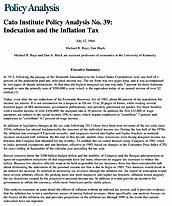Today, even after the tax reductions of the Economic Recovery Act of 1981, about 80 percent of the population file income tax returns. It is not uncommon for a taxpayer to fill out 15 to 20 pages of forms, while reading several hundred pages of IRS instructions, government publications, and privately purchased tax guides. For those families with a taxable income of over $106,000, the marginal rate is 50 percent. In addition the first $32,800 of wage payments are subject to the social security (FICA) taxes, which require employers to “contribute” 7 percent and employees to “contribute” 6.7 percent of wage income .
In addition to legislative changes in the tax code following 1913 (there have been nine revisions of the tax code since 1954), inflation has altered fundamentally the structure of the individual income tax. During the last half of the 1970s the inflation rate averaged 8.9 percent annually, and taxpayers moved into higher and higher brackets as nominal incomes increased with inflation. By the end of that decade, middle class Americans were facing marginal income tax brackets that Congress had intended for the wealthy. To combat this so-called bracket creep, Congress in 1981 voted to index personal exemptions and rate brackets, effective in 1985, based on changes in the Consumer Price Index (CPI) for years ending in September of the calendar year preceding the tax year.
Recent concerns about the $200 billion budget deficit and the inability of Congress and the Reagan administration to agree on expenditure reductions of that magnitude have led many observers to suggest tax increases to reduce the deficit. Because few elective officials want to be held responsible for tax increases, there has been considerable talk about eliminating the indexation of the personal income tax that is due to begin in 1985. This measure would result in an indirect tax increase. In addition to increasing tax revenues through the inflation tax, the repeal of indexation would have several arbitrary effects. By pushing more and more taxpayers into higher tax brackets, inflation would magnify the tax distortions created by the progressive personal income tax. In addition it would provide an incentive for government to inflate the currency, while most Americans prefer stable prices.
This analysis examines in some detail the effects of inflation without an indexed tax system, and it provides evidence that the inflation tax is not a satisfactory means of raising federal revenues. More specifically, our analysis focuses on the history of the inflation tax and provides projections of the inflation tax through 1990 in the event that current indexation laws are repealed.
Our evidence indicates that the inflation tax grew tenfold during the 1970s. By 1980 the average American family needed roughly 50 percent more income than in 1958 just to be able to pay the inflation tax. Moreover, the inflation tax is not uniformly paid by individuals in different income classes. While inflation pushes the poor and middle class into higher tax brackets, the wealthy remain in the 50 percent bracket. Our projections through 1990 suggest that the real tax bill of a family with $5,000 in taxable income in 1985 will increase by 92.8 percent in just five years under an unindexed tax system and a 10 percent annual inflation rate. In contrast, the real tax bill of a family with $200,000 in taxable income will increase only 8.7 percent under the same conditions of five years of 10 percent inflation.

